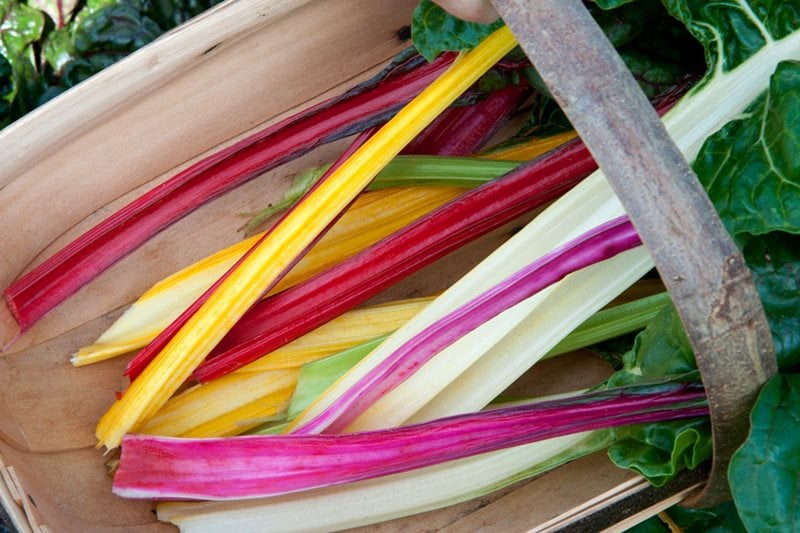
- Botanical name: Beta vulgaris subsp. cicla
- Origins: Chard is a cultivated descendant of the wild sea beet
- First cultivated: Chard can be traced back to ancient times. It supposedly grew in the Hanging Gardens of Babylon, and was cultivated in Ancient Rome around 300-400 BC
- Types: Comes in many colours, with varieties including multicoloured 'Bright Lights' and crimson-red 'Rhubarb Chard'
- Skill level: Easy
- Preferred location and conditions: Prefers rich, moisture-retentive soil in an open, sunny site
- Good for containers: Yes
- Planting and growing: Sow thinly from March to July, 2.5 cm deep and 10 cm apart, in rows 45 cm apart. Alternatively, sow in modules and plant out 2-4 weeks later
- Harvest time: Spring sowings should be ready to harvest from about 12 weeks and regular pickings will ensure a continuous supply. Seeds sown in July will be ready to harvest throughout the autumn and winter
- Possible problems: Mildew and grey mould can be a problem in humid weather. Ensure there is plenty of space surrounding the plants to improve air circulation
Did you know?
Chard has had a long and distinguished history. Prized for its medicinal properties as much as its culinary versatility, ancestors of this colourful vegetable supposedly grew in the fabled Hanging Gardens of Babylon, flourished in China during the 7th century BC, and were even written about by Aristotle in Ancient Greece.
It has grown in Britain since at least 1596, when English botanist, John Gerard, recorded growing it in his famous Herball. Its name comes from the Latin word for ‘thistle’ (carduus) but the vegetable goes by many alternative names including, silver beet, beet spinach, seakale beet, and leaf beet. It is also commonly referred to as Swiss chard, although since the plant originated in the Mediterranean, this prefix is somewhat misleading. It is thought that the Dutch seed merchants of the 19th century added the word ‘Swiss’ to differentiate the plant from French spinach varieties.
Despite being revered in ancient times, chard is a little overlooked these days, which is a shame, as it’s easy to grow, extremely good for you, and beautiful to look at. The multi-coloured stems of the 'Bright Lights' variety are particularly eye-catching and a welcome sight on winter allotments when there is little colour.
A nutrient-packed leafy green, chard is milder than kale but has an earthy sweetness that packs more punch than spinach. Young leaves can be eaten raw in salads and the mature leaves can be steamed, boiled, stir-fried, and added to tarts, stews and sauces. It is extremely popular in Italian cooking, and a key ingredient in the traditional torta pasqualina (Easter pie), combined with ricotta and hard boiled-eggs, and encased in pastry. The real culinary advantage of chard, however, is that you get two vegetables for the price of one, as the succulent stalks are a delicacy in themselves. They require a little extra cooking, so cook them separately to the leaves, chopping them like celery and sweating them with onions at the start of a dish. It is worth noting that chard doesn’t keep well in the fridge, a few days at most, so it’s always advisable to eat the stalks and leaves fresh.
Once used as a cure for a variety of ailments including dandruff, anaemia, jaundice and toothache, these days, a diet rich in chard is known to decrease the risk of obesity, diabetes and heart disease. It is packed with antioxidants, and contains high levels of vitamins K, A and C, magnesium, potassium, iron and fibre. Eating plenty of chard can help maintain bone health, improve digestion, regulate blood sugar levels and contribute to healthy brain function. Chard also contains chlorophyll which, according to numerous studies, may be effective in combatting cancer.
Chard is an excellent leaf to grow in your garden. It’s an easier crop than spinach, can tolerate extremes of temperature and is very prolific. Research also suggests it can even grow in space! Chard was one of a handful of crops tested as part of NASA’s Veggie Project to determine the best way to grow vegetables for long-term space missions.
Text provided by Mr Fothergill's.
RHS Grow Your Own
RHS advice: How to grow chard
Mr Fothergill's

